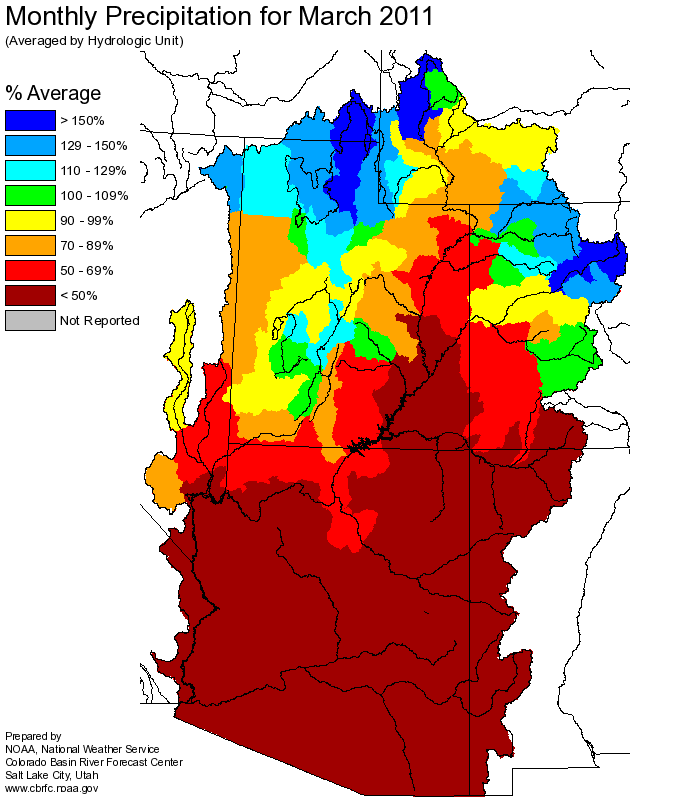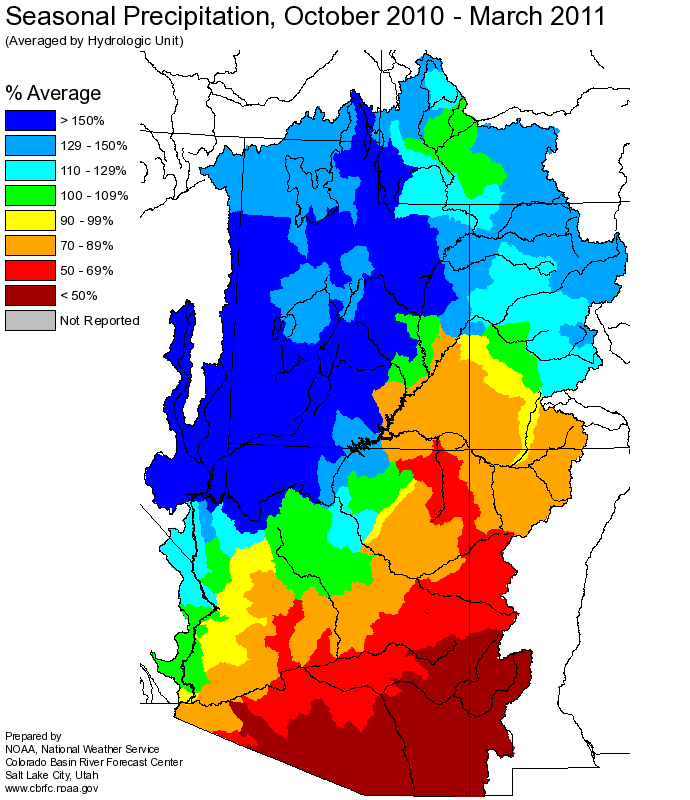Note: This publication is currently undergoing major revisions. The current publication will be replaced with a new publication based on stakeholder requirements and scientific advances. We expect to begin sharing details on this soon. If you have input on content, format, or publication frequency at any time, please contact us at cbrfc.webmasters@noaa.gov.Lake Powell Water Supply Outlook, April 1, 2011Lake Powell Water Supply Outlook, April 1, 2011
Contents
Lake Powell Sub-Basin Summaries
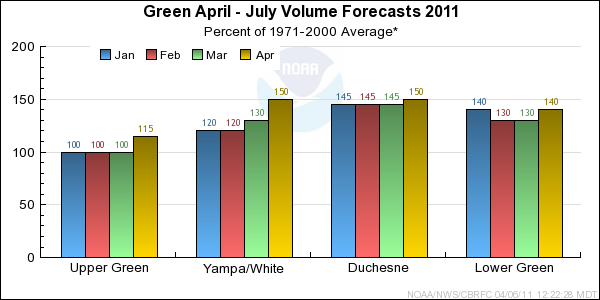
*Median of forecasts within each basin.
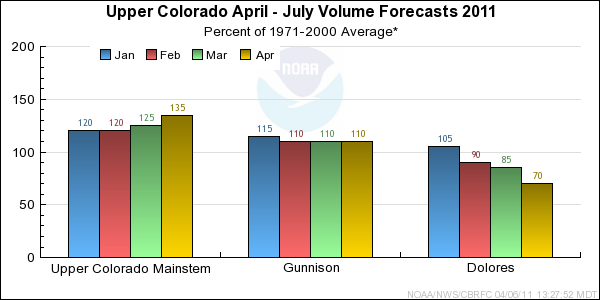
*Median of forecasts within each basin.
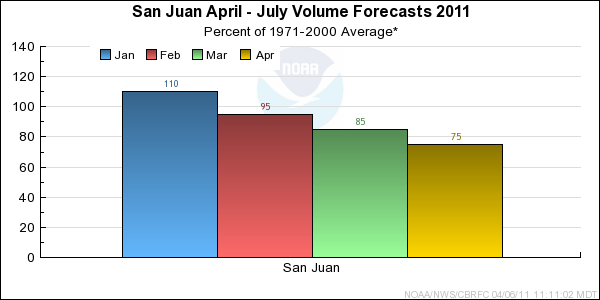
*Median of forecasts within each basin.
Upper Green Basin Conditions
The following conditions influenced this month's forecasts:
Precipitation:
Seasonal October through March
precipitation was 125 percent of average
in the Upper Green basin. March
precipitation was 105 percent of average in
the basin as a whole; however, portions of the basin received much above average precipitation
such as the headwaters of the mainstem of the Green River which received near 150 percent of average.
Snow:
April 1st snow water equivalent was 120 percent of average in the basin.
--- Upper Green basin
snow
water equivalent plot.
Streamflow:
March streamflow was near 80 percent of average.
Soil Moisture:
Modeled
soil
moisture states were below average heading into the winter.
Climate Forecasts:
Climate forecasts were not a factor because there is not a strong correlation
between La Nina conditions and winter precipitation in the Upper Green basin.
Forecast Summary:
With the addition of another month of near average precipitation and localized areas
with much above average precipitation, the seasonal precipitation and snow water
equivalent still remain above average for the Upper Green. As a result of the
current conditions, the April through July streamflow volume forecasts increased
by approximately 5 to 10 percent from the March 1 forecasts. Current forecasts
range between 100 and 140 percent of average with a median value of 114 percent.
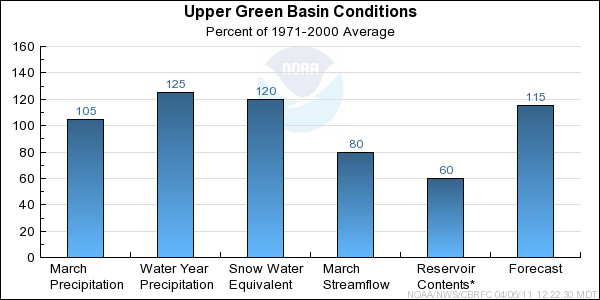
* Percent usable capacity, not percent average contents.
Click for multi-month Graph.
Yampa/White Basin Conditions
The following conditions influenced this month's forecasts:
Precipitation:
Seasonal October through March
precipitation was 130 percent of average
in the Yampa/White basin. March
precipitation was 120 percent of average in
the basin as a whole.
Snow:
April 1st snow water equivalent was 130 percent of average in the basin.
--- Yampa basin
snow
water equivalent plot.
Streamflow:
March streamflow was near 100 percent of average.
Soil Moisture:
Modeled
soil
moisture states were near average heading into the winter for the Yampa, Little Snake,and
White River basins.
Climate Forecasts:
Climate forecasts were not a factor in the forecasts because there is not a strong correlation
between La Nina conditions and winter precipitation in the Yampa/White basin.
Forecast Summary:
With the addition of above average precipitation in March,
the seasonal precipitation and current snow water equivalent remain
much above average. It is also important to note that many of the snotel locations
have record or near record snow water equivlent for this time of the year.
As a result of the current conditions, the April through July streamflow volume
forecasts have increased by approximately 10 to 20 percent. Current forecasts
range between 128 and 162 percent of average with a median value of 151 percent.
Many of these forecast volumes are in the top five historical observed volumes.
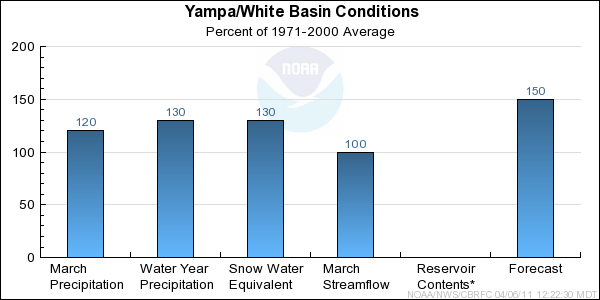
* Percent usable capacity, not percent average contents.
Click for multi-month Graph.
Duchesne Basin Conditions
The following conditions influenced this month's forecasts:
Precipitation:
Seasonal October through March
precipitation was 155 percent of average
in the Duchesne basin. March
precipitation was 85 percent of average the basin
as a whole; however, portions of the basin received much below average precipitation
such as the headwaters of Ashley Creek, Big Brush, and Whiterocks.
Snow:
April 1st snow water equivalent was 145 percent of average in the basin.
--- Duchesne basin
snow
water equivalent plot.
Streamflow:
March streamflow was 90 percent of average.
Soil Moisture:
Modeled
soil
moisture states were much below average to below average heading into the winter.
Climate Forecasts:
Climate forecasts were not a factor in the forecasts because there is not a strong correlation
between La Nina conditions and winter precipitation in the Duchesne basin.
Forecast Summary:
Seasonal precipitation and current snow water equivalent still remain much
above average in spite of the below average March precipitation. As a result of the
current conditions, the majority of the April through July streamflow volume forecasts
did not change from March. However, forecasts for the Duchesne, Strawberry, and Rock Creek
rivers have increased by approximately 5 to 10 percent while forecasts for Ashley Creek, Big Brush, and
Whiterocks have decreased by approximately 5 to 10 percent as a result of the much below average
March precipitation. Current forecasts range between 106 and 193 percent of
average with a median value of 153 percent.
Many of these forecast volumes are
in the top five historical observed volumes.
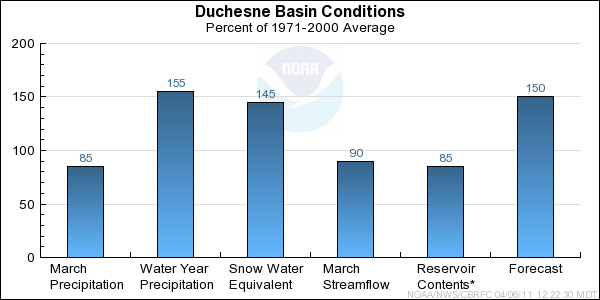
* Percent usable capacity, not percent average contents.
Click for multi-month Graph.
Lower Green Basin Conditions
The following conditions influenced this month's forecasts:
Precipitation:
Seasonal October through March
precipitation was 160 percent of average
in the Lower Green basin. March
precipitation was 90 percent of average.
Snow:
April 1st snow water equivalent was 120 percent of average in the basin
as a whole.
--- Lower Green basin
snow
water equivalent plot.
Streamflow:
March streamflow was near 80 percent of average.
Soil Moisture:
Modeled
soil
moisture states were much below to near average heading into the winter.
Climate Forecasts:
Climate forecasts were not a factor in the forecasts because there is not a strong correlation
between La Nina conditions and winter precipitation in the Lower Green basin.
Forecast Summary:
With the addition of near average precipitation in March,
the seasonal precipitation and current snow water equivalent remain much
above average and above average, respectively. As a result of the current
conditions, the April through July streamflow volume forecasts are similar
to the March forecasts with the exception of Green River at Green River, UT
which increase by 11 percent. Current forecasts range between 121 and 151 percent
of average with a median value of 141 percent.
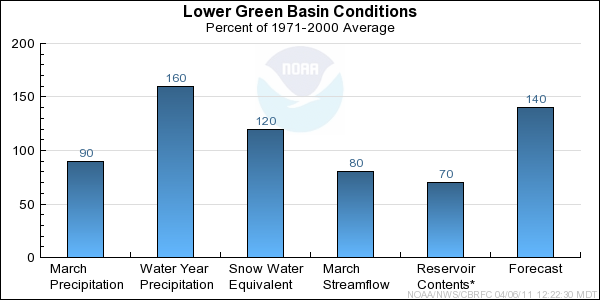
* Percent usable capacity, not percent average contents.
Click for multi-month Graph.
Upper Colorado Mainstem Basin Conditions
The following conditions influenced this month's forecasts:
Precipitation:
Seasonal October through March
precipitation
remains much above average in the Upper Colorado mainstem basin at 130 percent of average.
March
precipitation was near 125 percent of
average in the basin as a whole. However, the uppermost headwaters of the basin
received near 150% of average precipitation for the month.
Snow:
April 1st snow water equivalent was near 130 percent of average in the basin
as a whole. This is significant for this time of year as it is also near 130%
of the average seasonal peak. Many snotel sites in the upper portion of the
basin have snow water equivalent values in the top 5% of their historical records,
with a few at record levels.
--- Upper Colorado basin
snow
water equivalent plot
Streamflow:
March streamflow was near 100 percent of average.
Soil Moisture:
Modeled
soil
moisture states were near to above average heading into the winter.
Climate Forecasts:
Climate forecasts were not a factor because there is not a strong correlation
between La Nina conditions and winter precipitation in the Upper Colorado mainstem basin.
Forecast Summary:
Almost all forecast volumes were raised from last month due to yet another
month of above average precipitation combined with the much above average snow water
equivalent at this point in the season. Current April through July streamflow volume
forecasts range between 120 and 150 percent of average with a median
value of 135 percent.
Many of these forecast volumes are in the top five of historical
volumes observed since 1970.
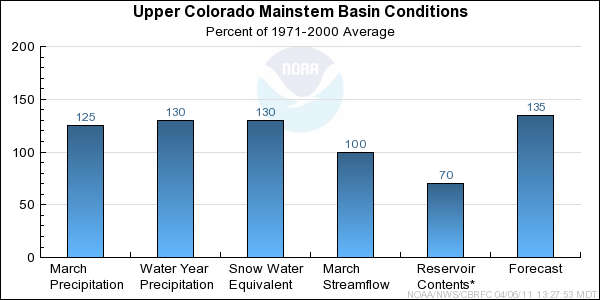
* Percent usable capacity, not percent average contents.
Click for multi-month Graph.
Gunnison Basin Conditions
The following conditions influenced this month's forecasts:
Precipitation:
Seasonal October through March
precipitation was 115 percent of average
in the Gunnison basin. March
precipitation was 90 percent of average.
Snow:
April 1st snow water equivalent was near 115 percent of average in the Gunnison basin; this is around 110% of the seasonal peak.
--- Gunnison basin
snow
water equivalent plot
Streamflow:
March streamflow was 90 percent of average.
Soil Moisture:
Modeled
soil
moisture states were below to near average heading into the winter.
Climate Forecasts:
Climate forecasts were not a factor because there is not a strong correlation
between La Nina conditions and winter precipitation in the Gunnison basin.
Forecast Summary:
March precipitation throughout the Gunnison basin was average at 90%. Seasonal precipitation for the Gunnison basin dropped a little from last month to 115% of average.
April 1st seasonal snow water equivalent for the Gunnison was above average with 115%; whereas the snow water equivalent is 110% of the average seasonal peak.
Since there was a slight increases in the seasonal snow water equivalent in the northern portions of the Gunnison basin, the current April through July streamflow
volume forecasts remained the same from last month's forecast. Current April through July streamflow volume
forecasts range
between 83 and 133 percent of average with a median value of 110 percent.
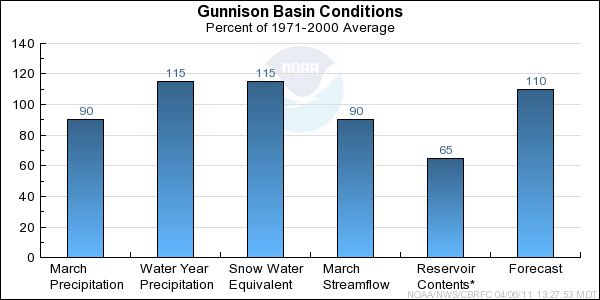
* Percent usable capacity, not percent average contents.
Click for multi-month Graph.
Dolores Basin Conditions
The following conditions influenced this month's forecasts:
Precipitation:
Seasonal October through March
precipitation was 95 percent of average
in the entire Dolores basin. March
precipitation was just 60 percent of average.
Snow:
April 1st snow water equivalent was 85 percent of average in the Dolores basin as a whole; this is about 75% of the seasonal peak.
--- Dolores basin
snow
water equivalent plot
Streamflow:
March streamflow was 60 percent of average.
Soil Moisture:
Modeled
soil
moisture states were average to slightly below average heading into the winter.
Climate Forecasts:
The correlation of La Nina and April through July water volumes in the Dolores basin is small that
it did not influence the forecast process.
Forecast Summary:
March precipitation throughout the Dolores basin was much below average at 60%. Seasonal precipitation for the Dolores basin dropped from last month to 95% of average.
April 1st seasonal snow water equivalent for the Dolores was average with 85%; whereas the snow water equivalent is 75% of the average seasonal peak.
Since the percent of average for both seasonal snow water equivalent and seasonal precipitation decreased from last month, the current April through July streamflow volume forecasts
dropped in the Dolores Basin from last month's forecast. Current April through July streamflow volume
forecasts range between
68 and 71 percent of average, with a median value of 70 percent.
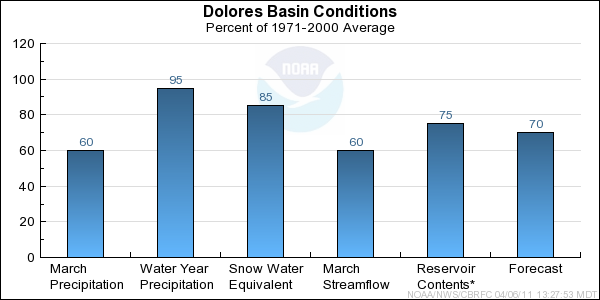
* Percent usable capacity, not percent average contents.
Click for multi-month Graph.
San Juan Basin Conditions
The following conditions influenced this month's forecasts:
Precipitation:
Seasonal October through March precipitation was 90 percent of average, which dropped 10 percent from March 1st.
March
precipitation was 50 percent of average, which was much below average.
Snow:
Current snow water equivalent for the entire basin is 85 percent, which is below average. The Animas basin and above Navajo are similar with 85 percent. All three dropped since March 1st.
--- Animas River Basin
Snow Plot.
--- Above Navajo Basin
Snow Plot.
Streamflow:
Streamflow for the entire San Juan Basin was much below average for March at 45%. Seasonal streamflow since October
continued to be much below average at 60%, due to the much below average fall precipitation.
Soil Moisture:
Modeled
soil
moisture as of November 1st, 2010 was average to below average across the entire San Juan Basin.
Climate Forecasts:
The correlation of La Nina and April through July water volumes in the San Juan basin does suggest slightly drier than average December through May precipitation,
but it did not influence the April forecast process.
Forecast Summary:
Since March precipitation was below to much below average in the San Juan Basin, the April Water Supply April-July volume dropped 10 percent. The
April-July forecast were down compared to last month with a range from 70 to 88 percent of average. The median value of 75 percent.
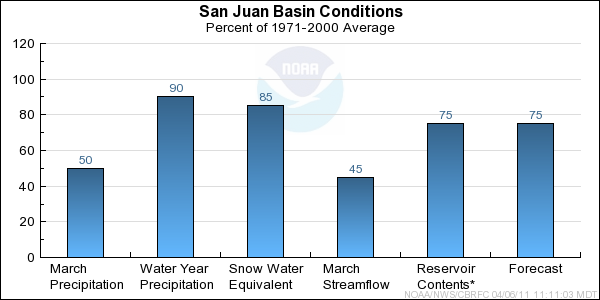
* Percent usable capacity, not percent average contents.
Click for multi-month Graph.
Differences between the full period forecasts and the residual forecasts may not exactly equal the actual observed volumes due to rounding conventions (see Definitions section).
Reservoir Monthly Inflow Forecasts
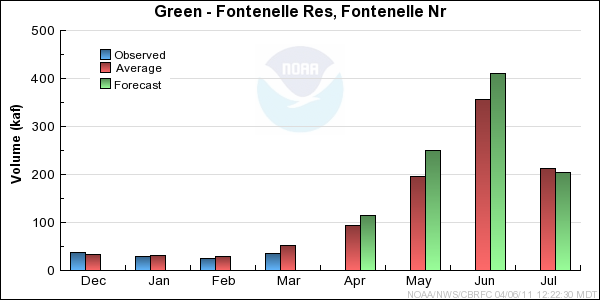
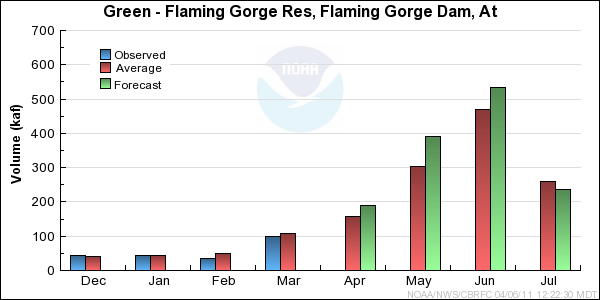
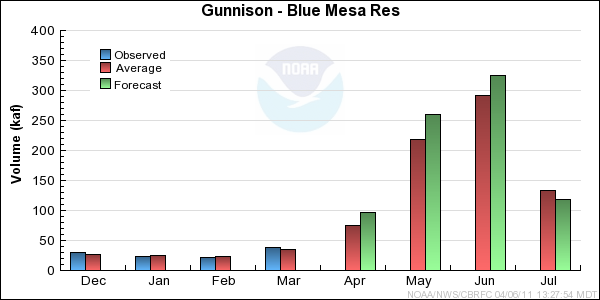
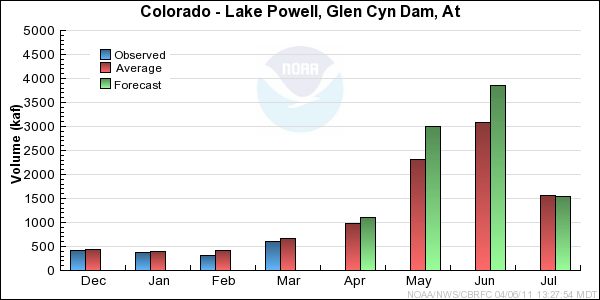
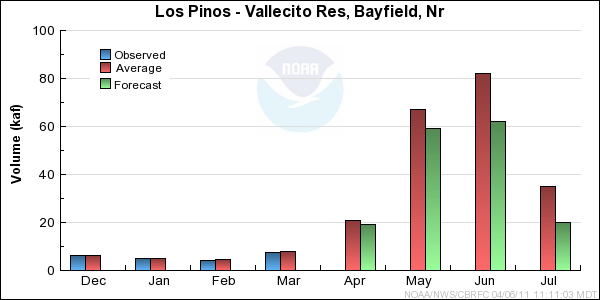
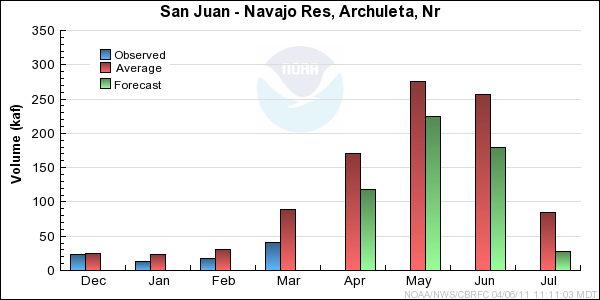
Monthly Streamflows
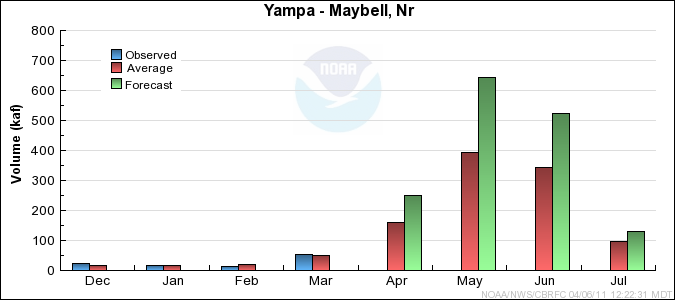
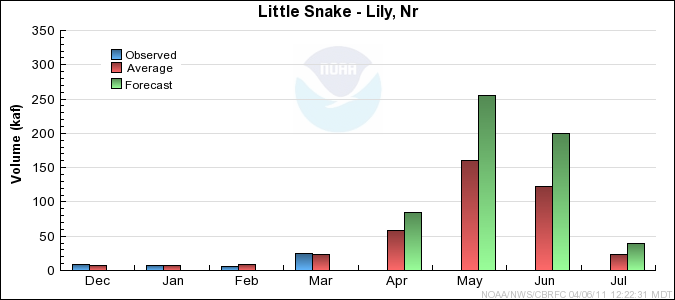
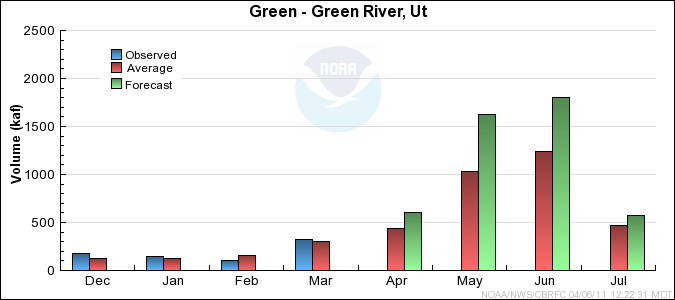
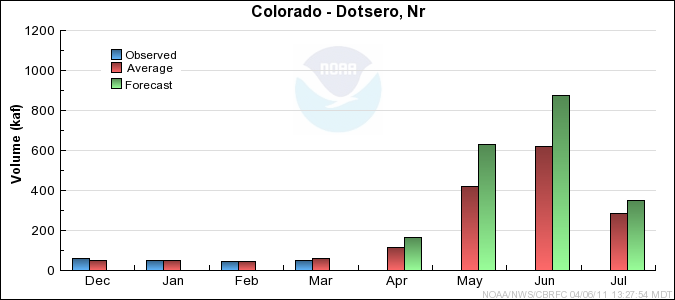
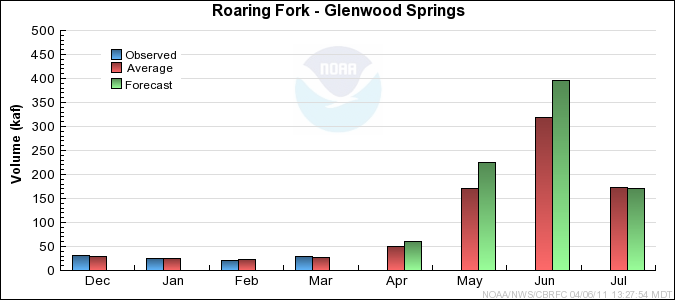
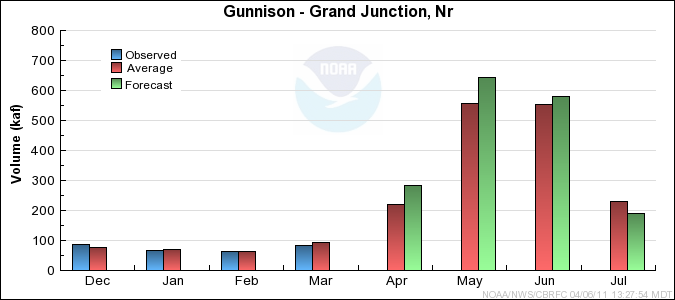
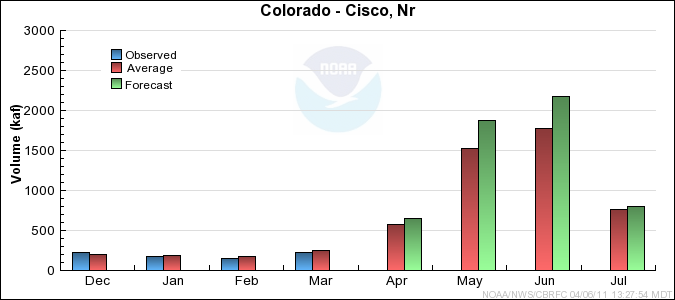
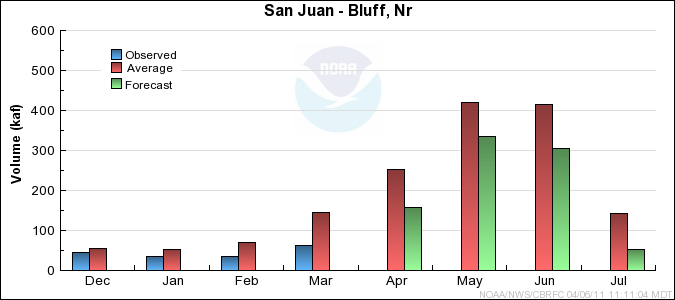
Precipitation Maps
